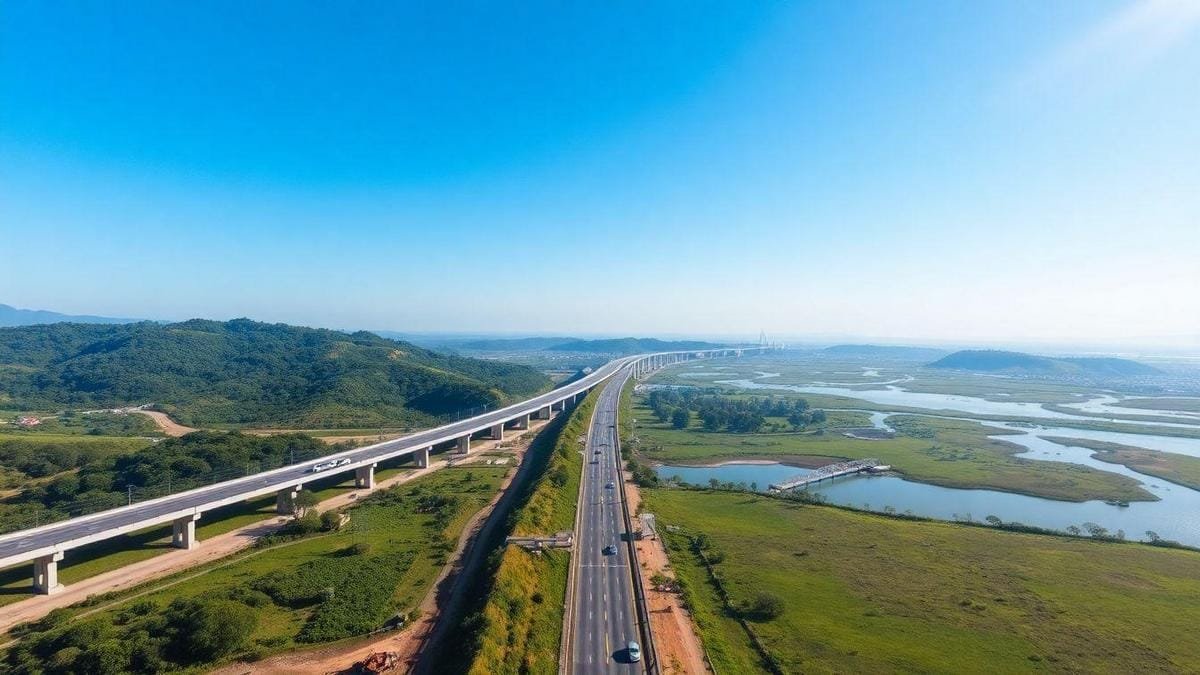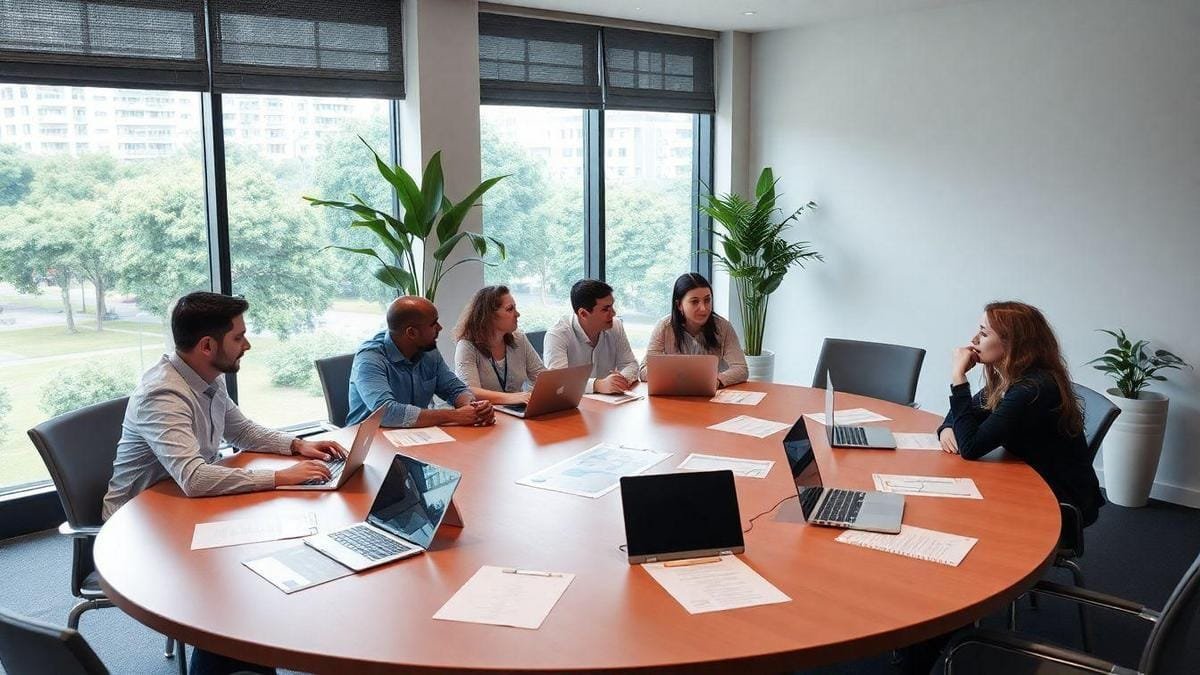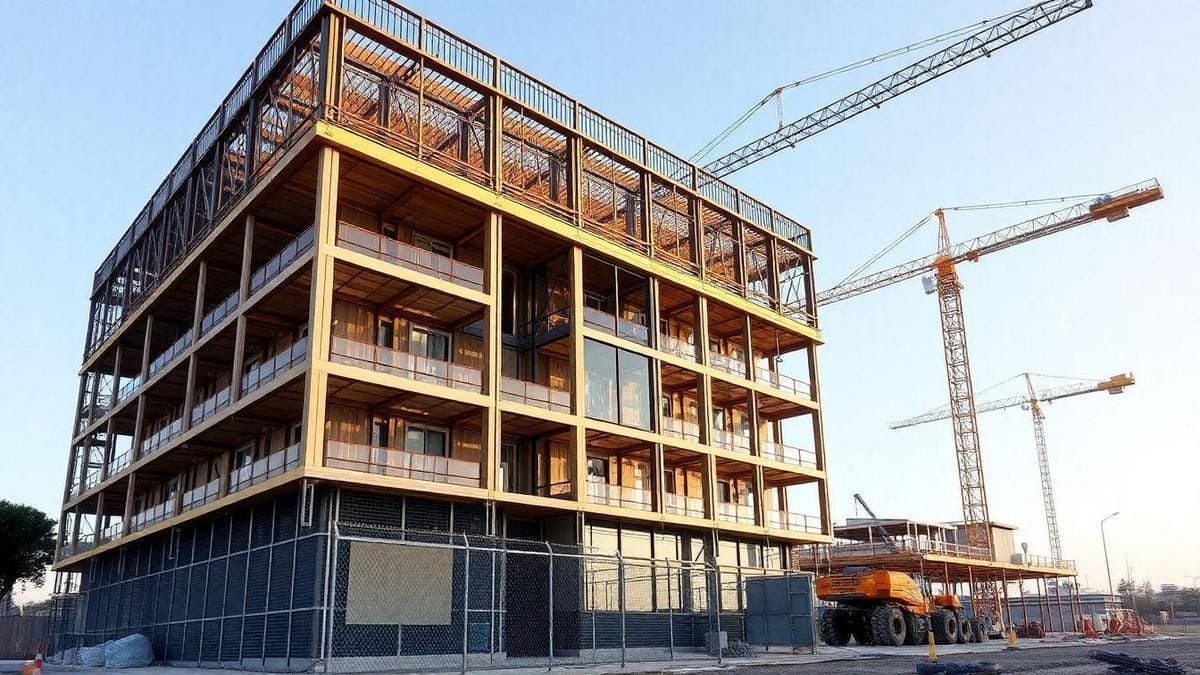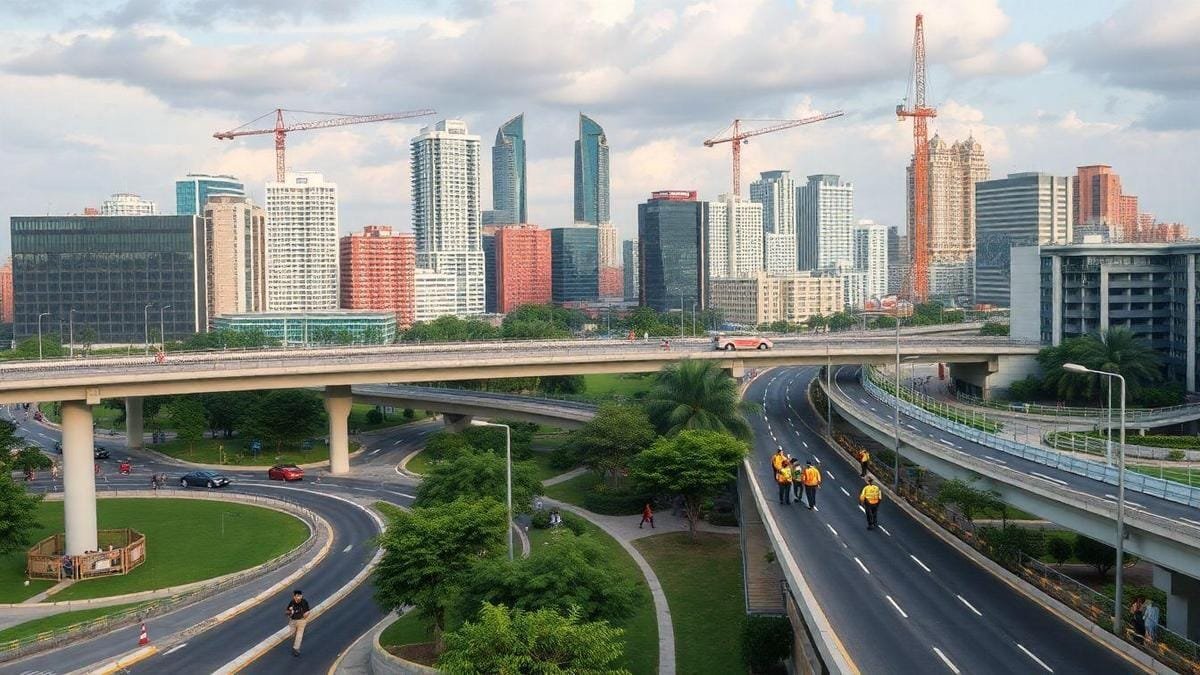Listen to this article
Feasibility analysis of infrastructure projects in Brazil is like the map that guides great works. In this article, you'll find out why this analysis is so important. essential to make sure everything runs smoothly. Let's explore the benefits for society, how to choose local strategies and the importance of architecture. We will also talk about technologies that transform the construction and planning that make a difference. Get ready to understand the impact of these gigantic projects on your daily life!
Main conclusions
- Feasibility is key for infrastructure projects.
- Study costs before starting a project.
- Always consider the environmental impact.
- Involve the community in decisions.
- Improve the local economy with new projects.

The Importance of Feasibility Analysis for Infrastructure Projects in Brazil
What is Feasibility Analysis?
A feasibility analysis is a study that helps to understand whether a project is worthwhile. It involves looking at the costs, benefits and risks. Imagine you want to build a bridge. Before you start, you need to know whether the project will bring more advantages than disadvantages. It's like planning a trip: you check whether the destination is worthwhile and whether you have the money to go.
Why is it essential for infrastructure projects?
For infrastructure projects such as roads, bridges and buildings, this analysis is even more important. Have you ever heard of Rio-Niterói Bridge? This bridge was a milestone in the connectivity between the two cities. Before it was built, the engineers carried out a detailed analysis. They studied traffic, environmental impact and economic viability. This preparation helped ensure that the bridge would bring many benefits, which can be seen at studies on the benefits of building bridges.
Direct benefits of analysis for society
Feasibility analysis brings many direct benefits to society. Here are some of them:
- Reducing costsBy identifying problems before you start, you avoid spending money on future corrections.
- Better planningHelps to define a realistic timetable and choose the most suitable construction methods.
- Increased securityWith a proper study, the risks can be minimized, guaranteeing the safety of the population.
- Social benefits: Well-planned projects create jobs and improve quality of life.
| Benefits | Description |
|---|---|
| Reducing costs | Savings by avoiding rework. |
| Better planning | A more realistic and efficient schedule. |
| Increased security | Minimizing risks for the population. |
| Social benefits | Generating jobs and improving quality of life. |
The feasibility analysis of infrastructure projects in Brazil is therefore an essential tool to ensure that projects are successful and bring real benefits to everyone.
Examples of Major Infrastructure Works in Brazil
Rio-Niterói Bridge: A Landmark of Connectivity
A Rio-Niterói Bridge is one of Brazil's most impressive infrastructure projects. Inaugurated in 1974, this bridge connects the cities of Rio de Janeiro and Niterói, significantly reducing the travel time between them. The project was designed by the architect Eurico Gaspar Dutra and its construction took about 4 years. For a detailed analysis of costs and construction time, see here.
Project details:
- Location: The bridge crosses Guanabara Bay.
- Construction methodWe used the cantilever constructionThis allowed large sections to be assembled without the need for temporary supports.
- TechnologyHigh-strength materials and modern techniques were used for the time.
Benefits generated:
- Reducing traffic: The bridge facilitates the daily commute of thousands of people.
- Economic developmentThe connection between the two cities has boosted trade and tourism.
Maracanã Stadium: A Symbol of Culture
O Maracanã Stadium is more than just a venue for sporting events; it's an icon of Brazilian culture. Inaugurated in 1950, it underwent significant renovations for the 2014 World Cup. The original project was by Archimedes Memory e Cartier Bresson.
Project details:
- Location: Located in Rio de Janeiro, it is surrounded by some of the most beautiful urban scenery in the world.
- Construction methodThe structure is made up of a combination of concrete, steel and glass, guaranteeing durability and aesthetics.
- TechnologyThe use of state-of-the-art sound and lighting systems turns every event into a unique experience.
Benefits generated:
- Cultural impact: The Maracanã is a meeting place for fans and sports lovers.
- Job creationWith frequent events, the stadium creates job opportunities and boosts the local economy.
Impact of these works on urban mobility
Works such as the Rio-Niterói Bridge and the Maracanã Stadium have a direct impact on urban mobility. They not only facilitate transportation, but also promote social and economic development. The connection between cities and the creation of leisure spaces are essential for the growth of a society. For more information on the social impact of large buildings, visit here.
| Work | Location | Opening Year | Main benefits |
|---|---|---|---|
| Rio-Niterói Bridge | Rio de Janeiro/Niterói | 1974 | Traffic reduction, economic development |
| Maracanã Stadium | Rio de Janeiro | 1950 (renovated in 2014) | Cultural impact, job creation |

Choice of Location and its Impact on Viability
How does location affect project success?
A location he foundation of a building site is like the foundation of a house: if it's not done right, the whole thing could collapse. When you think about an infrastructure project, the choice of location can make all the difference. This is because a good site can facilitate access, attract investment and benefit the community. On the other hand, a poorly chosen site can lead to extra costs and delays. It is therefore essential that you consider several factors when deciding where to build. To better understand the importance of urban planning, see here.
Examples of well-chosen locations in Brazil
A striking example is São Paulo's cable-stayed bridge. Located in the south of the city, the bridge connects important avenues and has significantly improved traffic in the area. The architectural design is modern and impressive, and the choice of location was strategic, as it facilitated access to commercial and residential areas.
Another notable work is Amazon Arenain Manaus. The location was designed to meet the demand for sporting and cultural events, as well as boosting tourism in the region.
Factors to consider when choosing a location
When choosing a site for an infrastructure project, it is important to consider:
- AccessibilityIs the site easily accessible for vehicles and pedestrians?
- Environmental ImpactWill the construction affect the surrounding nature?
- DemographicsDoes the local population need the work?
- Existing infrastructureAre services such as water, electricity and sewage available?
| Factor | Description |
|---|---|
| Accessibility | Facilitates the flow of people and vehicles. |
| Environmental Impact | Evaluate the damage to nature. |
| Demographics | It understands the needs of the local population. |
| Infrastructure | Checks the availability of essential services. |
Architectural Projects and their Role in Viability
The importance of design in a successful project
When we talk about architectural projectsdesign is fundamental. Not only does it bring the work to life, but it also influences it. feasibility. A good design can facilitate construction and ensure that the work meets the needs of the community. For example Rio-Niterói BridgeThe bridge, one of the most iconic in Brazil, was designed to connect two important cities. The bridge's design has enabled it to withstand heavy traffic, reducing travel times and improving the quality of life of the people who use it. For more details on the architectural design of large bridges, visit here.
Examples of innovative architectural projects
An impressive example of innovation is Museum of Tomorrowin Rio de Janeiro. This museum is not only a cultural space, but also an example of how architecture can be sustainable. The project, signed by Santiago CalatravaThe building incorporates technologies that help reduce energy consumption. Construction took around three years and was designed to blend in with the natural environment of the area. Flamengo Beach.
| Aspect | Details |
|---|---|
| Location | Flamengo Beach, Rio de Janeiro |
| Construction time | 3 years |
| Architecture Project | Santiago Calatrava |
| Technology used | Sustainability and energy efficiency |
| Benefits for society | Tourist attraction and environmental education |
How architecture can reduce costs
Efficient architecture can help reduce costs in various ways. For example, by using local materials and construction methods that minimize waste, the project ends up being more economical. In addition, a good feasibility analysis of infrastructure projects in Brazil foundations is crucial. This ensures that resources are used in the best way and that the work brings real benefits to the population. To find out more about construction methods, check out here.
A Ponte Estaiada in São Paulo is another example. Its modern design has not only beautified the city, but also facilitated traffic in the area. The use of state-of-the-art technology during its construction helped keep costs under control and the work was finished in record time.

Construction Methods and their Influence on Feasibility Analysis
Traditional versus modern methods
When you think of constructionThe most common of these come to mind: traditional methods such as masonry and wood. But what about modern methods? They use cutting-edge technology and are faster and more efficient. For example Rio-Niterói BridgeOne of the largest in Brazil, it was built using techniques that mixed the traditional with the new, allowing it to be completed in just four years, from 1968 to 1972.
Examples of methods used on large construction sites
Let's take a look at some major Brazilian construction projects and how the construction methods were chosen:
| Work | Construction method | Construction time | Technology used |
|---|---|---|---|
| Rio-Niterói Bridge | Precast concrete | 4 years | Metal structures |
| Maracanã Stadium | Steel structures | 3 years | Roofing technology |
| Itaipu Power Plant | Concrete dam | 8 years | Water control system |
These examples show how the choice of method can have an impact on the time and efficiency of the work.
Advantages of choosing the right method
Choosing the right method is crucial. A good method can:
- Reduce costs: Less waste of materials.
- Speed up the work: Less construction time.
- Increase security: Modern methods can be safer.
For example Itaipu Power Plant used a construction method that allowed tighter control over quality, resulting in a work that is not only an engineering marvel, but also brings continuous benefits to society.
Construction Time and its Relevance
How does time impact the cost of the project?
When you think of an infrastructure project, such as the Rio-Niterói BridgeConstruction time is a crucial factor. O cost The cost of a project is not just about the materials and labor, but also about the time it takes to complete the work. The longer it takes, the more money you spend. For example, if the construction of a bridge takes months longer than planned, this can increase costs due to:
- Additional laborMore time means more wages.
- Materials: The price of materials can increase over time.
- FinesDelays may result in contractual penalties.
Examples of delayed projects and their consequences
A notable example is São Gonçalo do Amarante International Airportwhich faced significant delays. Construction was initially expected to take 24 months, but ended up taking 36 months. The consequences were:
- Increased costs: The project cost more than expected.
- Impact on the local economyThe delay meant that the region lost out on potential investment and jobs.
Strategies to optimize construction time
To avoid these problems, some strategies can be adopted:
- Detailed planningBefore you start, it's essential to have a clear plan.
- Technology: Using technology as 3D modeling can help you visualize the project and avoid mistakes.
- Communication: Maintaining good communication between everyone involved is essential for resolving problems quickly.
| Strategy | Benefits |
|---|---|
| Detailed planning | Reduces risks and increases efficiency |
| Use of technology | Minimizes errors and speeds up processes |
| Good communication | Facilitates problem solving |
Planning Stages in Infrastructure Projects
What are the main stages of planning?
When we talk about infrastructure projectsPlanning is essential. Here are the main steps you should consider:
- Defining ObjectivesWhat do you want to achieve? One example is Rio-Niterói Bridgewhich connected two major cities.
- Feasibility AnalysisBefore starting, it is crucial to carry out a feasibility analysis of infrastructure projects in Brazil foundations. This helps to understand whether the project is financially and technically viable. For more information on project analysis, see here.
- Architectural design: Here, the architects and engineers create the drawings. A Pantanal Arenafor example, was designed with sustainability in mind.
- Licensing and approvals: You need to obtain government permits. This stage can be time-consuming, but it is important for the legality of the project.
- ExecutionThis is the construction phase. A Belo Monte power plant took years to build, but has brought many benefits. To understand the social impact of the dam's construction, visit here.
- Monitoring and EvaluationAfter construction, the use and effectiveness of the infrastructure must be monitored.
The importance of each stage for the success of the project
Each of these steps is like a piece of a puzzle. If one piece fails, the whole may not work. For example, if feasibility analysis is not done well, you could end up with a project that doesn't meet expectations or isn't financially sustainable.
In addition, the architectural design is fundamental. Good design can make infrastructure not only functional, but also a landmark in the city, such as the Brasília Cathedralwhich is admired for its beauty and innovation. For more on the importance of famous architects, see here.
Examples of effective planning in Brazil
Here are some examples of projects that have been effectively planned and have brought significant benefits to society:
| Project | Location | Construction time | Benefits generated |
|---|---|---|---|
| Rio-Niterói Bridge | Rio de Janeiro | 4 years | Reduced travel time |
| Pantanal Arena | Cuiabá | 3 years | Stimulating tourism and sporting events |
| Belo Monte power plant | Pará | 6 years | Energy generation and jobs |
These projects show how good planning can transform people's lives. A Rio-Niterói Bridgefor example, has not only improved traffic, but also connected families and friends.
Technology Used in Infrastructure Projects
Technological innovations transforming construction
When we talk about technology in infrastructure projects, it's impossible not to think about how innovations have changed the way we build. A clear example of this is Octávio Frias de Oliveira cable-stayed bridgein São Paulo. This bridge is not just a crossing over the river, but a symbol of modernity. The project used advanced calculations and 3D modeling software to ensure that every detail was perfect. To learn more about advanced construction technology, see here.
The 3D printing e drones have been increasingly used to monitor construction work and ensure that everything goes according to plan. In addition augmented reality allows engineers to visualize the project before construction even begins, making the process more efficient.
Examples of technology applied to major construction projects
Let's take a look at how the technology is applied on some major construction sites in Brazil. Here are a few examples:
| Work | Technology used | Benefits generated |
|---|---|---|
| Octávio Frias de Oliveira cable-stayed bridge | 3D Modeling, Structural Calculations | Safety and efficiency in construction |
| Corinthians Arena | BIM (Building Information Modeling) | Reduced costs and deadlines |
| São Paulo Metro | Intelligent Control Systems | Better passenger flow |
Each of these works brought real benefits for society, such as improving transportation and safety. The use of new technologies not only speeds up the process, but also reduces costs and increases the quality of construction.
The future of technology in Brazilian infrastructure
The future of technology in Brazilian infrastructure is promising. With the increase in digitization and the use of artificial intelligenceWe can expect even safer and faster construction. A feasibility analysis of infrastructure projects in Brazil foundations will become more accurate, allowing investors to make more informed decisions.
In addition, sustainability is becoming a priority. Technologies that help reduce environmental impact will become increasingly common. This means that, in the future, you'll be able to see buildings that not only meet society's needs, but also take care of our planet.

Social and Economic Benefits of Infrastructure Projects
How do these projects impact the local economy?
When we talk about infrastructure projectssuch as Rio-Niterói BridgeWhen the bridge was inaugurated in 1974, we immediately thought about how these major works can transform a region. The bridge, inaugurated in 1974, not only facilitated traffic between the cities of Rio de Janeiro and Niterói, but also boosted local trade. With less travel time, people began to work and shop in places that used to be far away.
In addition, the construction of the bridge generated thousands of jobs. This is a clear example of how a project can bring direct benefits for the local economy. By receiving their salaries, the workers have injected money into the communities, helping to create more businesses and services. For more on the social impact of large construction projects, see here.
Examples of social benefits generated by major construction projects
Major projects, such as the transposition of the São Francisco riverThese projects also have a significant impact. This project was designed to bring water to the arid regions of the Northeast. The social benefits are obvious:
- Access to drinking waterMany communities that previously faced severe drought now have access to clean water.
- Improved healthWith water available, diseases related to lack of sanitation decrease.
- Increased agricultural production: Farmers can irrigate their crops and increase production.
| Social Benefit | Description |
|---|---|
| Access to drinking water | Communities with clean and available water. |
| Improved health | Reduction of water-related diseases. |
| Increased production | Farmers are able to irrigate and increase harvests. |
The importance of financing sustainable projects
Financing sustainable projects is essential. Not only do they help society, but they are also a form of investing in the future. One example is the construction of ecological roadsThey are designed to minimize environmental impact. These roads are designed to withstand traffic while preserving the local vegetation and fauna.
When funding is directed towards these initiatives, you are supporting environmentally friendly development and generates long-term benefits. This is crucial, especially in a Brazil that seeks to grow in a way that responsible and aware.
Conclusion
In short, the feasibility analysis of infrastructure projects in Brazil is a fundamental tool that cannot be ignored. It not only ensures that projects are financially sustainablebut also ensures that they bring real benefits for society. When considering factors such as location, technology e planningYou are building a solid foundation for success. So when faced with a new project, remember: good planning and detailed analysis can make all the difference.
If you want to delve even deeper into this topic and explore other valuable tips on renovation and infrastructure, be sure to visit Renovation Tips.
Frequently asked questions
What is feasibility analysis for infrastructure projects in Brazil?
The feasibility analysis of infrastructure projects in Brazil helps to see if a project can happen. You check money, time and resources.
Why is it important to do this analysis?
It's essential to avoid wasting money and time. You want to be sure that the project is viable before you start.
What factors are assessed in the analysis?
Costs, deadlines, benefits and risks are checked. All to make sure the project is viable.
What data is needed for the analysis?
You need information on cost, market, competition and local laws. The more data, the better.
How does the analysis impact project financing?
A viable project attracts investors. If the analysis shows problems, it's difficult to get money.
What are foundations in infrastructure projects?
Foundations are the basis of a project. They support the entire construction and guarantee safety.
Who does this feasibility analysis?
Usually, specialized consulting firms carry out the analysis. But you can also do it in-house.
How long does it take to do a feasibility analysis?
It can take from weeks to months. It depends on the complexity of the project.
What happens if the analysis is negative?
If it's negative, you should rethink or adjust the project. Perhaps it needs further study.
Is it possible to redo the analysis after a while?
Yes, you can revise the analysis if new data or changes occur.
How does feasibility analysis affect planning?
It helps you plan better. With solid data, you can decide on the next steps.
Does Brazilian legislation influence the feasibility analysis?
Yes, a lot! Local laws directly affect what can and can't be done.
What common mistakes occur in feasibility analysis?
Some people make the mistake of underestimating costs or ignoring risks. This can cause serious problems later on.

I'm passionate about sharing the fascinating world of engineering. In this blog, we'll embark on a journey through innovative projects, cutting-edge technologies and the challenges of construction. If you're an enthusiast, a student or just curious about how things are built, this is the place for you! Get ready to uncover the secrets behind bridges, buildings, tunnels and other engineering marvels.

